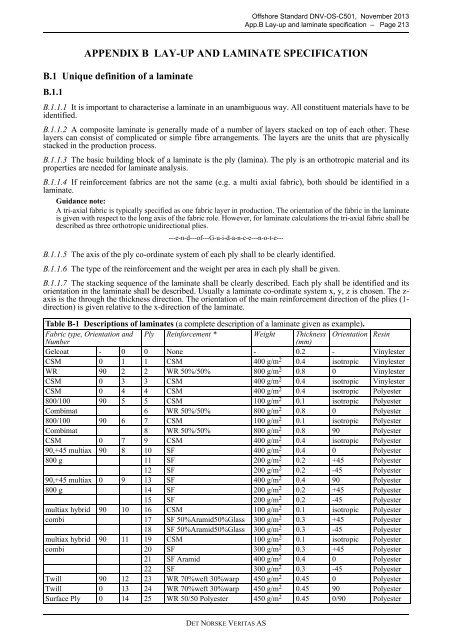OS-C501
You also want an ePaper? Increase the reach of your titles
YUMPU automatically turns print PDFs into web optimized ePapers that Google loves.
Offshore Standard DNV-<strong>OS</strong>-<strong>C501</strong>, November 2013<br />
App.B Lay-up and laminate specification – Page 213<br />
APPENDIX B LAY-UP AND LAMINATE SPECIFICATION<br />
B.1 Unique definition of a laminate<br />
B.1.1<br />
B.1.1.1 It is important to characterise a laminate in an unambiguous way. All constituent materials have to be<br />
identified.<br />
B.1.1.2 A composite laminate is generally made of a number of layers stacked on top of each other. These<br />
layers can consist of complicated or simple fibre arrangements. The layers are the units that are physically<br />
stacked in the production process.<br />
B.1.1.3 The basic building block of a laminate is the ply (lamina). The ply is an orthotropic material and its<br />
properties are needed for laminate analysis.<br />
B.1.1.4 If reinforcement fabrics are not the same (e.g. a multi axial fabric), both should be identified in a<br />
laminate.<br />
Guidance note:<br />
A tri-axial fabric is typically specified as one fabric layer in production. The orientation of the fabric in the laminate<br />
is given with respect to the long axis of the fabric role. However, for laminate calculations the tri-axial fabric shall be<br />
described as three orthotropic unidirectional plies.<br />
---e-n-d---of---G-u-i-d-a-n-c-e---n-o-t-e---<br />
B.1.1.5 The axis of the ply co-ordinate system of each ply shall to be clearly identified.<br />
B.1.1.6 The type of the reinforcement and the weight per area in each ply shall be given.<br />
B.1.1.7 The stacking sequence of the laminate shall be clearly described. Each ply shall be identified and its<br />
orientation in the laminate shall be described. Usually a laminate co-ordinate system x, y, z is chosen. The z-<br />
axis is the through the thickness direction. The orientation of the main reinforcement direction of the plies (1-<br />
direction) is given relative to the x-direction of the laminate.<br />
Table B-1 Descriptions of laminates (a complete description of a laminate given as example).<br />
Fabric type, Orientation and Ply Reinforcement * Weight Thickness Orientation Resin<br />
Number<br />
(mm)<br />
Gelcoat - 0 0 None - 0.2 - Vinylester<br />
CSM 0 1 1 CSM 400 g/m 2 0.4 isotropic Vinylester<br />
WR 90 2 2 WR 50%/50% 800 g/m 2 0.8 0 Vinylester<br />
CSM 0 3 3 CSM 400 g/m 2 0.4 isotropic Vinylester<br />
CSM 0 4 4 CSM 400 g/m 2 0.4 isotropic Polyester<br />
800/100 90 5 5 CSM 100 g/m 2 0.1 isotropic Polyester<br />
Combimat 6 WR 50%/50% 800 g/m 2 0.8 0 Polyester<br />
800/100 90 6 7 CSM 100 g/m 2 0.1 isotropic Polyester<br />
Combimat 8 WR 50%/50% 800 g/m 2 0.8 90 Polyester<br />
CSM 0 7 9 CSM 400 g/m 2 0.4 isotropic Polyester<br />
90,+45 multiax 90 8 10 SF 400 g/m 2 0.4 0 Polyester<br />
800 g 11 SF 200 g/m 2 0.2 +45 Polyester<br />
12 SF 200 g/m 2 0.2 -45 Polyester<br />
90,+45 multiax 0 9 13 SF 400 g/m 2 0.4 90 Polyester<br />
800 g 14 SF 200 g/m 2 0.2 +45 Polyester<br />
15 SF 200 g/m 2 0.2 -45 Polyester<br />
multiax hybrid 90 10 16 CSM 100 g/m 2 0.1 isotropic Polyester<br />
combi 17 SF 50%Aramid50%Glass 300 g/m 2 0.3 +45 Polyester<br />
18 SF 50%Aramid50%Glass 300 g/m 2 0.3 -45 Polyester<br />
multiax hybrid 90 11 19 CSM 100 g/m 2 0.1 isotropic Polyester<br />
combi 20 SF 300 g/m 2 0.3 +45 Polyester<br />
21 SF Aramid 400 g/m 2 0.4 0 Polyester<br />
22 SF 300 g/m 2 0.3 -45 Polyester<br />
Twill 90 12 23 WR 70%weft 30%warp 450 g/m 2 0.45 0 Polyester<br />
Twill 0 13 24 WR 70%weft 30%warp 450 g/m 2 0.45 90 Polyester<br />
Surface Ply 0 14 25 WR 50/50 Polyester 450 g/m 2 0.45 0/90 Polyester<br />
DET NORSKE VERITAS AS



